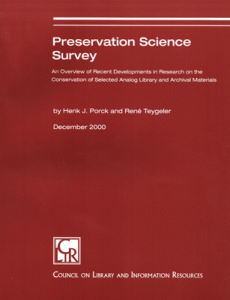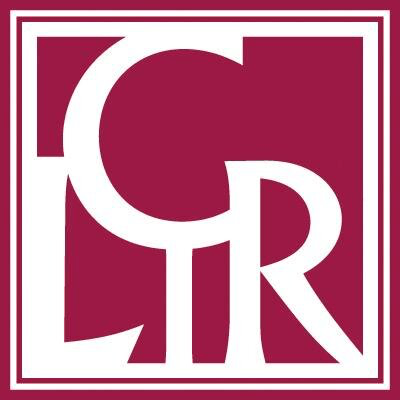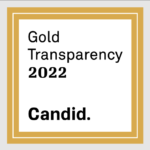Preservation Science Survey
An Overview of Recent Developments in Research on the Conservation of Selected Analog Library and Archival Materials
by Henk J. Porck and René Teygeler
December 2000
Published in cooperation with the European Commission on Preservation and Access
Copyright 2000 by the Council on Library and Information Resources. No part of this publication may be reproduced or transcribed in any form without permission of the publisher. Requests for reproduction should be submitted to the Director of Communications at the Council on Library and Information Resources.
- Summary
- Objectives
- Setup and approach
- Outline and outlook
- Decay
- Treatment
- Storage
Chapter 3: Film And Photographic Materials
- Decay
- Treatment
- Storage
- Decay
- Treatment
- Storage
- Decay
- Treatment
- Storage
Appendix I: Addresses of contacts and institutes, by country
Appendix II: Index of projects noted in survey, by institute
About the Authors
Henk J. Porck studied biochemistry at the Free University (VU) of Amsterdam. His Ph.D. thesis was a biochemical-genetic study at the VU Medical Faculty Department of Anthropogenetics. In 1983 he was appointed conservation scientist at the Koninklijke Bibliotheek (KB), the National Library of the Netherlands in The Hague. His research on paper preservation has included studies on deacidification, artificial aging, ink corrosion, and discoloration. In 1991 he became curator of the KB Paperhistorical Collection. His work in paper history has concentrated on the investigation of historical sources about the quality of nineteenth-century paper and on the classification and identification of handmade decorated papers.
René Teygeler started his academic career with a study in sociology and social psychology at Utrecht University. In 1988 he was appointed teacher in bookbinding and graphic techniques at the Amsterdam School of Printing. He completed his education as a book and paper conservator at the State School for Conservators in 1993, and was appointed conservator at the Koninklijke Bibliotheek in The Hague. He continued his academic training in anthropology at Leiden and Utrecht University, and obtained an honorary degree in 1996. His research projects in preservation concentrated on the tropics in general and non-Western manuscripts in particular. He has studied writing materials from South and Southeast Asia, and was involved in a research project on Indonesian writing materials at Leiden University. In 1997 he started the consultancy firm Paper in Development and has since advised many projects in developing countries on preservation, papermaking, and book production.
Acknowledgments
The authors acknowledge the assistance of KB coworkers Clemens B. J. de Wolf (Collections and Research), Hans J. Jansen (Research and Network Services), and Wim J. Th. Smit (Conservation and Optical Technology). They are also indebted to the individual researchers and research institutes that provided the information on which this overview is based. Finally, the authors would like to thank those who read and commented upon earlier drafts of this report: Chandru Shahani (Library of Congress), Hans Rütimann, and Jim Reilly and Franziska Frey (Image Permanence Institute).
Preface
Maintaining original physical objects-evidence or artifacts-for scholarly use in the future remains a primary responsibility of research libraries, archives, and museums, even as more and more information is created in digital form. Most of our recent history, the record of the nineteenth and twentieth centuries, is kept on film, magnetic tape, and paper.
Today, great sums of money are being spent to digitize materials for broader access. In many cases, electronic availability has boosted demand for the original. Nevertheless, concern with preserving the original seems to have fallen out of fashion. In the United States in recent years, digitization projects and acquisition of electronic resources have received greater emphasis than has traditional preservation. We are concerned that new interests-both of local institutions and of funding agencies-may jeopardize preservation budgets. It is therefore more important than ever that funds for preservation be spent wisely on measures that are appropriate, effective, safe, and economical.
In commissioning the Koninklijke Bibliotheek to undertake this study, the Council on Library and Information Resources aimed to provide information on recent significant developments in the preservation of analog library and archival materials as well as a summary of informed opinion concerning where there are significant research gaps in preservation science. The review focuses on work being done in North America, Europe, and Australia. It is intended for those who make decisions about preservation as well as the foundations and other organizations that support such work. Recognizing that this survey cannot convey the full scope or detail of the research noted, the authors have provided contact information for the individuals and institutions mentioned in this survey and a list of references.
I am deeply grateful to the authors for their extensive and careful research, and to the Koninklijke Bibliotheek for its cooperation and support for this project.
Deanna Marcum
President
Glossary of Abbreviations
| AMIA | Association of Moving Image Archivists |
| ASTM | American Society for Testing and Materials |
| BPS | Blue Pink Scale |
| CA | controlled atmospheres |
| CCI | Canadian Conservation Institute |
| CGSB | Canadian General Standards Board |
| CLIR | Council on Library and Information Resources |
| CMI | critical moisture indicator |
| CRCDG | Centre de Recherches sur la Conservation des Documents Graphiques |
| DEZ | diethylzinc |
| DP | degree of polymerization |
| DRIFT | diffuse reflectance infrared Fourier transform spectrometry |
| DSC | differential scanning calorimetry |
| ECF | elemental chlorine-free |
| EOL | end-of-life |
| EtO | ethylene oxide |
| FICA | Film Institute Conditioning Apparatus |
| FPL | Forest Products Laboratory |
| FTIR | Fourier transform infrared spectrometry |
| GC/MS | gas chromatography coupled to mass spectrometry |
| HCFC | hydrochlorofluorocarbon |
| HFC | hydrofluorocarbon |
| IPM | integrated pest management |
| IPI | Image Permanence Institute |
| ISR | Institute for Standards Research |
| KB | Koninklijke Bibliotheek, The National Library of the Netherlands |
| LACLEPA | laser cleaning of paper and parchment |
| LE | life expectancy |
| MA | modified atmospheres |
| NARA | National Archives and Records Administration |
| NICH | Netherlands Institute for Cultural Heritage |
| NML | National Media Laboratory |
| NYPL | New York Public Library |
| PAT | photographic activity test |
| RH | relative humidity |
| SEPIA | Safeguarding European Photographic Images for Access |
| TGA | gas thermogravimetric analysis |
| TLC | thin-layer chromatography |
| TNO | Nederlandse Organisatie voor Toegepast Natuurwetenschappellijk Onderzoek (Netherlands Organization for Applied Scientific Research) |
| TWPI | time-weighted preservation index |
| UPAA | Universal Procedure for Archive Assessment |
| VELOXY | Very Low Oxygen |
| VOC | volatile organic compound |

